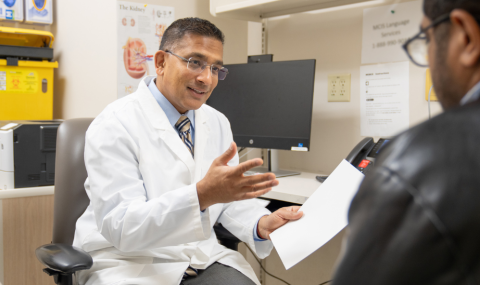Back to Cardiac Tests & Procedures
Introduction
A transesophageal echocardiogram (TEE) is a specialized form of echocardiogram, producing images of your heart from inside, rather than outside of your body; it is performed by a cardiologist with the help of a nurse and technologist. During a TEE, you swallow a small, flexible tube, through which the echo pictures are taken. This allows a view of the heart through the esophagus (the tube which connects your mouth and stomach), giving diagnostic information not possible from other perspectives.
This test can help us learn not only about various heart conditions, but also about acute problems, such as an aortic dissection (a tear in the main artery coming out of the heart). It can be given to patients in an operating room, an intensive care unit, or a hospital bed, so we can get important diagnostic information without moving a patient.
Risk Factors
Your physician will discuss the risk factors with you at the time of your appointment.
What to Expect Before the TEE
Before this test, you will be asked to sign a consent form. Talk to your doctor about any concerns you have regarding the need for the test, its risks, how it will be done, or what the results will indicate.
- Do not eat or drink for at least 6 hours before the TEE.
- If you have dentures or dental prostheses, you will need to remove them before the test.
- If you have any problems in swallowing or any acute abdominal pains, inform the doctor before the test.
You will need to remove any jewelry and clothes above your waist (you may be allowed to keep on your underwear if it does not interfere with the test). You may be given a cloth or paper covering to use during the test.
Your throat may be numbed with an anesthetic spray, to relax your gag reflex and to ease insertion of the probe. The spray may taste bitter and will make your tongue and throat feel numb and swollen. Some people report that they feel as if they cannot breathe at times because of the probe in their throat, but this is a false sensation caused by the anesthetic. There is always plenty of breathing space around the probe in your mouth and throat. Remember to relax and take slow, deep breaths.
Shortly before the procedure begins, an IV line will be placed in a vein in your arm. Medicine to decrease saliva and stomach secretions may be given through the IV. A sedative will be given to you through the IV in your arm during the procedure. You should feel relaxed and drowsy but still alert enough to cooperate. Other side effects, such as heavy eyelids, trouble speaking, a dry mouth, or blurred vision, may last for several hours after the test. You probably will not be able to remember much of the test.
What to Expect During the TEE
Your heart rate, breathing rate, and blood pressure will be monitored throughout the procedure. Also, a small device used to measure the amount of oxygen in your blood (pulse oximeter) may be attached to your finger or earlobe.
You will be asked to lie on your left side with your head tilted slightly forward. A mouth guard may be inserted to protect your teeth from the probe. Then, the lubricated tip of the probe will be guided into your mouth while your doctor gently presses your tongue out of the way. You may be asked to swallow to help move the tube along. It may be helpful to remember that the instrument is no thicker than many foods you swallow.
Once the probe is in your esophagus, it will be moved down gently to the level of your upper right heart chamber (atrium), and ultrasound images will be taken. You will not feel or hear the sound waves during the test. You may receive an IV injection of saline or contrast dye to help your doctor assess your heart function.
During the procedure, try not to swallow unless requested. You may gag, and feel nauseous, bloated, or have mild belly cramps when the probe is moved. If the discomfort is severe, alert your doctor with an agreed-upon signal or a tap on the arm. Even though you won't be able to talk during the procedure, you can still communicate. A nurse may remove the saliva from your mouth with a suction device, or you can just let the saliva drain from the side of your mouth.
A transesophageal echo is generally painless, though you may feel nauseated and uncomfortable while the probe is in your throat. The test takes about 1 hour. The probe will be in place in your esophagus for about 15 to 20 minutes.
What to Expect After the TEE
- You will not be able to drive for at least 12 hours after the procedure. Be sure to make arrangements in advance for someone to pick you up after the test.
- You may have a tickling, dry throat; slight hoarseness; or a mild sore throat. These symptoms may last for 2 to 3 days. Throat lozenges and warm saltwater gargles can help relieve these symptoms.
- Do not drink alcohol for 24 hours.
- Contact your doctor immediately if you have:
- Difficulty swallowing or talking
- Shortness of breath or a fast heartbeat
- Chest pain
Going Home
You can go home immediately after the test. There is no recovery or rehabilitation stage.
Follow-Up
Your referring or family doctor will contact you with the result. Usually, you will be contacted only if there is a problem with the results, unless otherwise stated by your doctor.



